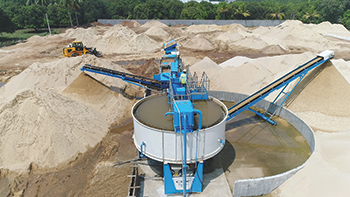Combo X150 reduces water use ‘by 95pc’
01 November 2018
Developed specially for the manufactured-sand (m-sand) washing market, CDE Asia’s new Combo X150 washing system integrates all washing processes from end-to-end in a single compact mobile unit.
The plant not only maximises production of m-sand but also reduces water consumption by 95 per cent, according to a company official.
“This is what makes the Combo the most eco-friendly sand washing system in the world,” says Manish Bhartia, managing director of CDE Asia. “It incorporates a water management system, making it extremely eco-friendly. The integrated water recycling and sludge management capability enables the plant to be deployed in areas where traditional sand washing systems cannot be used.”
Combo requires a small supply of fresh water as opposed to traditional systems which typically consume 10 to 15 times more water.
The other significant advantage is the low power consumption of 0.85 kW per tonne of feed – at just 170 kW maximum power rating – which makes Combo X150 the most power-efficient machine using clean energy, Bhartia says.
An intelligent remote monitoring platform is also on board the Combo X150, as an option. It enables real-time measurement of critical functions, storage of equipment-usage data for accurate diagnosis during service calls, and broadcast of user warnings for service requirement.
The Combo X150, with its production capability of 150 to 200 tonnes per hour, can be applied for washing a wide range of materials including m-sand, crushed rock fines, natural sand, and gravel. Due to its mobility, there is no requirement for bulky civil and structural work and the associated time-consuming process of dismantling and reinstallation.
A feeding system puts the feed material into the washing unit, which removes more than -75 microns fraction from the material, which is then forwarded to the dewatering unit that delivers washed, dewatered, and well-graded sand products of two grades of concrete and plaster sand via an integrated stockpile of conveyors.
Waste water from the system is transferred to an inbuilt recycling unit, where the solids are separated from the water. The recycled water is circulated back into the plant and the final waste silt is removed from the recycling unit in the form of concentrated sludge for easy recovery through the integrated EasySettle sludge management system. The technology to convert sludge into lightweight bricks for construction use is also provided by the CDE TechCentre.
- Compact Cobra ‘punches way above its weight’
- MKIII is first high-speed primary crusher
- Combo X150 reduces water use ‘by 95pc’



